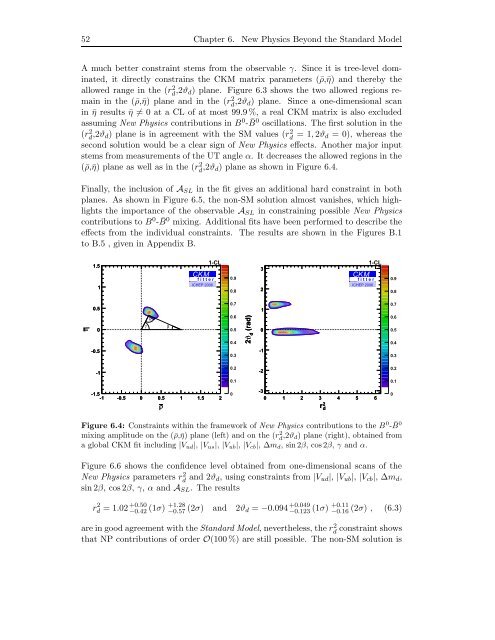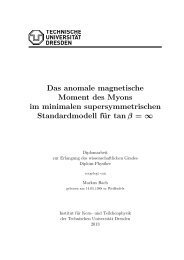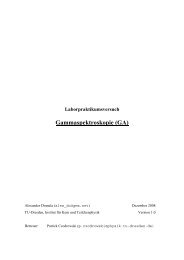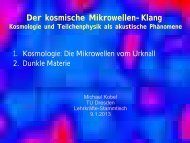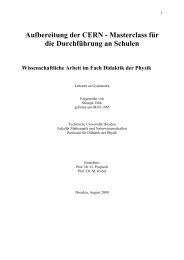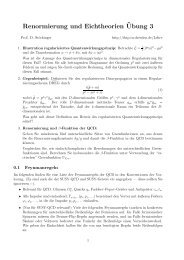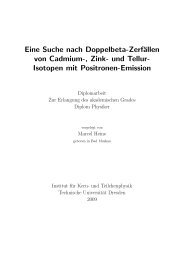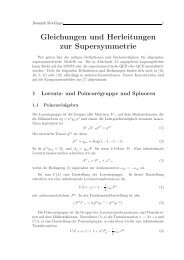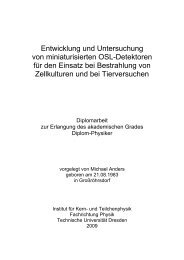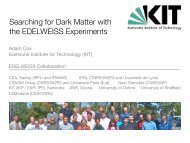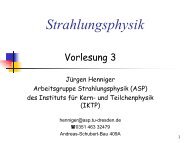A Mathematica based Version of the CKMfitter Package
A Mathematica based Version of the CKMfitter Package
A Mathematica based Version of the CKMfitter Package
Create successful ePaper yourself
Turn your PDF publications into a flip-book with our unique Google optimized e-Paper software.
52 Chapter 6. New Physics Beyond <strong>the</strong> Standard Model<br />
A much better constraint stems from <strong>the</strong> observable γ. Since it is tree-level dominated,<br />
it directly constrains <strong>the</strong> CKM matrix parameters (¯ρ,¯η) and <strong>the</strong>reby <strong>the</strong><br />
allowed range in <strong>the</strong> (r 2 d ,2ϑd) plane. Figure 6.3 shows <strong>the</strong> two allowed regions remain<br />
in <strong>the</strong> (¯ρ,¯η) plane and in <strong>the</strong> (r 2 d ,2ϑd) plane. Since a one-dimensional scan<br />
in ¯η results ¯η �= 0 at a CL <strong>of</strong> at most 99.9 %, a real CKM matrix is also excluded<br />
assuming New Physics contributions in B 0 - ¯ B 0 oscillations. The first solution in <strong>the</strong><br />
(r 2 d ,2ϑd) plane is in agreement with <strong>the</strong> SM values (r 2 d = 1, 2ϑd = 0), whereas <strong>the</strong><br />
second solution would be a clear sign <strong>of</strong> New Physics effects. Ano<strong>the</strong>r major input<br />
stems from measurements <strong>of</strong> <strong>the</strong> UT angle α. It decreases <strong>the</strong> allowed regions in <strong>the</strong><br />
(¯ρ,¯η) plane as well as in <strong>the</strong> (r 2 d ,2ϑd) plane as shown in Figure 6.4.<br />
Finally, <strong>the</strong> inclusion <strong>of</strong> ASL in <strong>the</strong> fit gives an additional hard constraint in both<br />
planes. As shown in Figure 6.5, <strong>the</strong> non-SM solution almost vanishes, which highlights<br />
<strong>the</strong> importance <strong>of</strong> <strong>the</strong> observable ASL in constraining possible New Physics<br />
contributions to B 0 - ¯ B 0 mixing. Additional fits have been performed to describe <strong>the</strong><br />
effects from <strong>the</strong> individual constraints. The results are shown in <strong>the</strong> Figures B.1<br />
to B.5 , given in Appendix B.<br />
η<br />
1.5<br />
1<br />
0.5<br />
0<br />
-0.5<br />
-1<br />
γ<br />
α<br />
-1.5<br />
-1 -0.5 0 0.5 1 1.5 2<br />
ρ<br />
β<br />
CKM<br />
1-CL<br />
f i t t e r<br />
ICHEP 2006<br />
0.9<br />
0.8<br />
0.7<br />
0.6<br />
0.5<br />
0.4<br />
0.3<br />
0.2<br />
0.1<br />
0<br />
(rad)<br />
d<br />
2 ϑ<br />
3<br />
2<br />
1<br />
0<br />
-1<br />
-2<br />
CKM<br />
1-CL<br />
f i t t e r<br />
ICHEP 2006<br />
-3<br />
0 1 2 3<br />
r 2<br />
d<br />
4 5 6<br />
Figure 6.4: Constraints within <strong>the</strong> framework <strong>of</strong> New Physics contributions to <strong>the</strong> B 0 - ¯ B 0<br />
mixing amplitude on <strong>the</strong> (¯ρ,¯η) plane (left) and on <strong>the</strong> (r 2 d ,2ϑd) plane (right), obtained from<br />
a global CKM fit including |Vud|, |Vus|, |Vub|, |Vcb|, ∆md, sin 2β, cos 2β, γ and α.<br />
Figure 6.6 shows <strong>the</strong> confidence level obtained from one-dimensional scans <strong>of</strong> <strong>the</strong><br />
New Physics parameters r 2 d and 2ϑd, using constraints from |Vud|, |Vub|, |Vcb|, ∆md,<br />
sin 2β, cos 2β, γ, α and ASL. The results<br />
r 2 d<br />
+0.50 +1.28<br />
= 1.02 −0.42 (1σ)<br />
−0.57 (2σ) and 2ϑd = −0.094 +0.049<br />
−0.123<br />
0.9<br />
0.8<br />
0.7<br />
0.6<br />
0.5<br />
0.4<br />
0.3<br />
0.2<br />
0.1<br />
+0.11<br />
(1σ) −0.16 (2σ) , (6.3)<br />
are in good agreement with <strong>the</strong> Standard Model, never<strong>the</strong>less, <strong>the</strong> r2 d constraint shows<br />
that NP contributions <strong>of</strong> order O(100 %) are still possible. The non-SM solution is<br />
0


